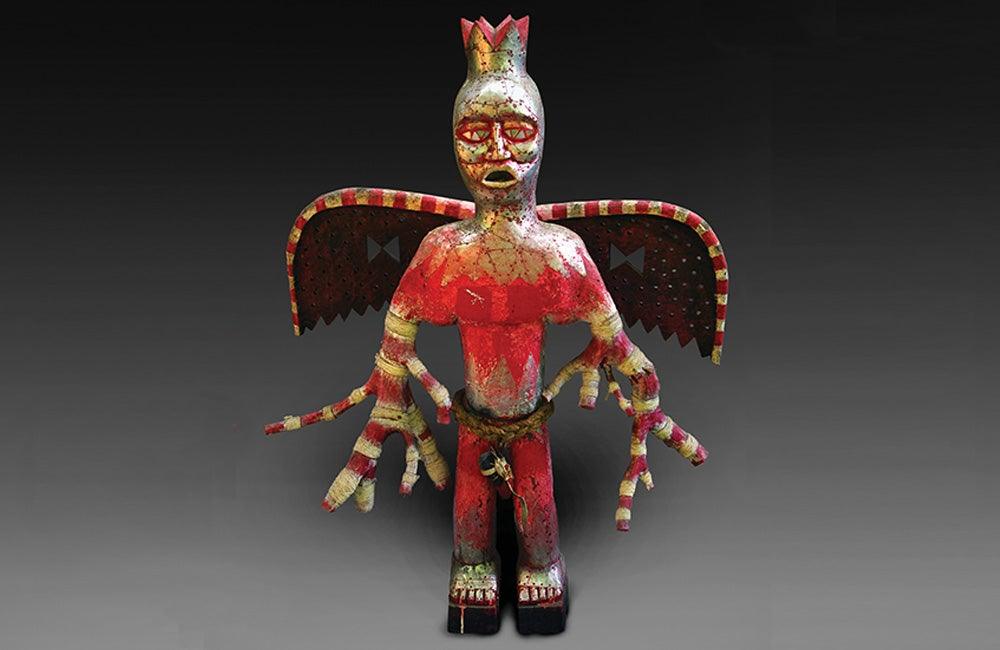First published: Summer 2018
Odinga Tyehimba didn’t intend to carve pieces that would become homes for spirits. And though he certainly had African spirituality in mind when he created his striking figures, he didn’t expect spirits to actually inhabit his carvings. Yet the spirits clearly thought otherwise. Tyehimba, a self-taught sculptor, had sensed this in the troubling dreams that plagued him while he was creating his pieces. But it wasn’t until friends visiting his home in Durham, North Carolina, kept reporting that they felt a distinct and often overpowering presence when they approached his carvings that he began to wonder what was happening.
At one point, a friend with a particularly spiritual bent reported that the spirits in the pieces had things to say. Channelling their messages, the friend began recounting details from Tyehimba’s past that he had never revealed. “It’s not like I could argue”, Tyehimba recalls. “I mean, how can I argue against someone who had information that there’s no way they could know?” Soon, other friends began to have the same experience.

For Brother Rosales, a piece prompted by a dream, and created to provide spiritual protection for a Palo priest who was the subject of magical attacks. The ritual blades – like the spikes, the chains, and the pot holding the piece – are iron, invoking the power of the orisha Ogún
At first Tyehimba resisted their explanations. It was too strange, too unreal. But they kept saying the same thing – asserting that the carvings were “alive” and he had “somehow created a doorway [such] that these beings in this other dimension, a subtler realm, can have some degree of agency in this world.”
“It was intimidating at first”, Tyehimba remembers. “But, in a way, it made sense, given all the things that I was experiencing in my dreams. Eventually, I just accepted that that’s where it was.”
Tyehimba’s journey since this moment of acceptance has led him much further into the spiritual realm, on a path partly guided by believers in the African Caribbean faith of Palo Mayombe. Local practitioners of this Cuba- and Kongo-based belief system have increasingly become Tyehimba’s principal clients, contending that his pieces can act as portals to another dimension.
While now recognising this potential in his carvings, Tyehimba nonetheless views himself as an artist who carves pieces that speak to black history and spirituality, and to his experiences as a veteran, father, spiritual seeker and black man living in the South. While honoured by the spirits’ presence, he recognises that his creations carry many messages that are his alone.
These messages – pointed, nuanced, multidimensional – have characterised Tyehimba’s work since he began carving more than two decades ago, at the age of 19. Mississippi-born Tyehimba was then in the Marines, and was increasingly aware of the racism that surrounded him both there and in the outside world. He traces the beginnings of this awareness to his final year in high school, when hip hop opened up a world of black history that he realised had pointedly not been part of his education. Always insistently inquisitive (his kin in Mississippi used to call him “an old soul”), Tyehimba set out to learn all he could about black nationalism, colonialism and the systemic structures of racism. What drew him to carving at the time was seeing a set of carved staffs in a hip hop video by the Afrocentric ensemble, X Clan. “I had never seen anything like that”, he recalls, “and I was completely inspired.”
If life in the Marines forced a regimented discipline, Tyehimba’s carving offered a conduit of release, channelling his increasingly angry political meditations. His first carved staff quickly led to others, each more complex and politically pointed. “There was a period where my work was just angry”, Tyehimba reflects. “Once I began to learn the truth about America’s hidden history – the true history of slavery and imperialism – my temperament became explosive. For me, the artistic process became a means of salvation from my own hostility.”
This is an article extract; read the full article in Raw Vision #98




